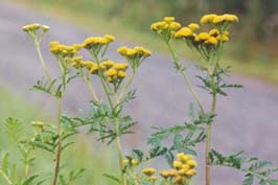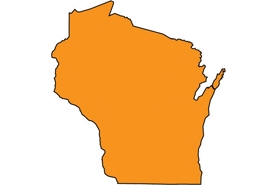Tansy
(Tanacetum vulgare)
Perennial herbaceous plant, 2-5' tall, erect, unbranched except for the flower head, stems slightly hairy, woody and purplish-red near the ground.
Other names for this plant include:
- Common names: common tansy, golden buttons, garden tansy
- Scientific names: Chrysanthemum vulgare; T. boreale
Classification in Wisconsin: Restricted (cultivars 'Aureum' and 'Crispum' are exempt).
- Ecological Threat
-
- Invades well-drained or sandy soils in open disturbed areas, roadsides, fields, prairies, pastures and hedgerows.
- Once established, infestations of common tansy displace native vegetation.
- Identification
-
Leaves: Alternate, pinnately compound with deeply divided, toothed, fern-like leaflets, 4-10" long and 1½-3" broad. Leaves are intensely aromatic when crushed.
Flowers: Bright yellow, button-like discs up to 0.5" wide in a flat-topped cluster blooming from July through October.
Fruits & seeds: Seeds are dispersed by wind and water.
Roots: Extensive spreading root system. Tansy regenerates from root fragments.
Similar species: Common tansy should not be confused with Lake Huron tansy (Tanacetum huronense; native), a Wisconsin endangered species which is shorter (16-23"), has fewer and more prominent flowers and is found on sandy beaches, lake dunes and cracks in limestone pavement.
- Control
-
Mechanical: Can be cut or mowed before flowering to prevent seed set. Removing the dead vegetation with controlled burns can make the plants easier to target with herbicides.
Chemical: Foliar spray rosettes in spring using dicamba, glyphosate, and metsulfuron-methyl with a surfactant, 2, 4-D, clopyralid or a mixture of 2, 4-D and clopyralid.
For more information on control techniques, visit the Tansy factsheet [exit DNR] by the University of Wisconsin-Extension.
- Resources
- Sources for content:
- Czarapata, Elizabeth; Invasive Plants of the Upper Midwest: an illustrated guide to their identification and control. The University of Wisconsin Press. 2005. Pg. 70-72



